The Samsung Galaxy S7 and S7 edge Review: Part 2
by Joshua Ho on July 5, 2016 8:00 AM ESTCamera Architecture and UX
In general, camera has become probably the single biggest point of differentiation between smartphones at this point. As smartphones are often the only camera that most people carry on a day to day basis, the rear camera on a smartphone really cannot be a disappointment relative to the competition. While we can talk about how much a front-facing camera matters in terms of quality, it’s pretty safe to say that for photos and videos that are worth saving will be taken with the rear-facing camera.
While post-processing and a number of other factors are going to have a huge impact on the overall camera experience, the foundation that makes it possible to deliver a great camera is always going to start at the hardware.
| Samsung Galaxy S Cameras | ||||
| Galaxy S6 Galaxy Note5 |
Galaxy S7 | |||
| Front Camera | 5.0MP | 5.0MP | ||
| Front Camera - Sensor | Samsung S5K4E6 (1.34 µm, 1/4.1") |
Samsung S5K4E6 (1.34 µm, 1/4.1") |
||
| Front Camera - Focal Length | 2.2mm (22mm eff) | 2.1mm (21mm eff) | ||
| Front Camera - Max Aperture | F/1.9 | F/1.7 | ||
| Rear Camera | 16MP | 12MP | ||
| Rear Camera - Sensor | Sony IMX240 Samsung S5K2P2 (1.12 µm, 1/2.6") |
Sony IMX260 Samsung S5K2L1 (1.4 µm, 1/2.6") |
||
| Rear Camera - Focal Length | 4.3mm (28mm eff) | 4.2mm (26mm eff) | ||
| Rear Camera - Max Aperture | F/1.9 | F/1.7 | ||
In the case of the Galaxy S7, Samsung has done something that I thought they’d never do, which is move backwards in resolution in order to improve pixel sensitivity. In the case of the Galaxy S7, Samsung has moved from the Sony IMX240/Samsung S5K2P2 to the Sony IMX260/Samsung S5K2L1 sensor, with a 1.4 micron pixel size relative to a 1.12 micron pixel pitch in the previous generation. This means that there’s a 56% increase in sensitivity per pixel. Assuming the same process technology, this does improve low light performance significantly. While to some extent it’s true that improved CIS (CMOS image sensor) technology can alleviate the downsides of smaller pixels, on the same technology you have to reduce your fill factor/active sensor area. The other problem is that while read noise on the sensor does reduce per pixel as you reduce pixel size, the overall sensor read noise trends upwards. This means that the region in which the CIS noise is primarily limited by shot noise is going to be smaller as you reduce pixel size. Shot noise is an unavoidable reality of existence, to the extent that even our eyes can see this “visual snow” if ambient light is sufficiently dim.
However, in the case of the Galaxy S7 I suspect that there’s more to the story, because the dual pixel AF system means that for each 1.4 micron pixel each pixel needs two photodetectors. In order to make phase detection work, there has to be sufficient spatial separation to make this system work properly, so some of the benefit of these larger pixels will inevitably be eaten up in order to enable PDAF that works in basically all lighting conditions.
The other notable change here is that the Galaxy S7 uses an even wider f/1.7 aperture. Unfortunately, in Samsung's efforts to try and make the module thinner they've made the focal length slightly shorter than before which results in an effective focal length of 26mm. This and the wider aperture could lead to compromises as light is entering the optics at a more extreme angle than before.
With these basics covered, we can move on to a discussion of the user experience. While in the past it was easy enough to just take some still shots on a tripod, a holistic view of camera quality really needs to take into account far more than just the end result. A poorly designed camera application with low resolution, low frame rate preview, improper preview aspect ratio, poor control layout, and other issues can easily make it difficult, if not impossible to get the photo that you want. These issues are thankfully getting less common, but these problems can make it almost impossible to recommend a phone for its camera, no matter how good the results are.
In the case of the Galaxy S7, the camera application is a nice upgrade over the Galaxy S6 at launch, but for the most part nothing is really different this go around. I’m not going to spend too much time here, but the short story is that I don’t think that Samsung is doing anything wrong here, and things are pretty much as good as they’re going to get.
While leaving it at that would be enough, I want to recognize some of the improvements that Samsung has implemented here. The major improvement here is that Pro mode is finally useful, as this mode now allows for adjusting auto-exposure and AF targets, in addition to EV, shutter speed, ISO, white balance with 100K granularity, and manual focus. The one notable shortfall here is that Samsung only allows 800 ISO max in manual ISO mode when the true maximum is 1250. For better or worse though, that’s the only notable problem I encountered with the camera app itself. It’s easy to think that Samsung hasn’t done anything notable here, but this is more a testament to the execution of design more than anything else.
However, before we move on to image quality testing, we can take a look at our focus and capture latency tests. For those that are unfamiliar, this is a fairly simple test designed to see how long it takes for a phone to focus and capture a scene on our standard ISO test chart in good lighting conditions, which can give a fairly good idea for best case latencies.
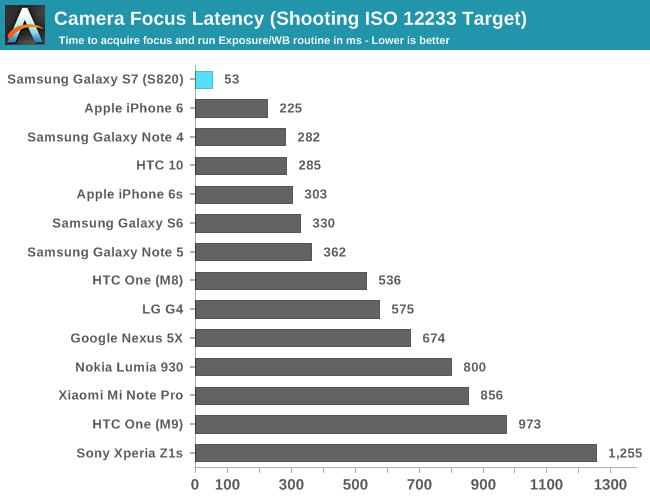
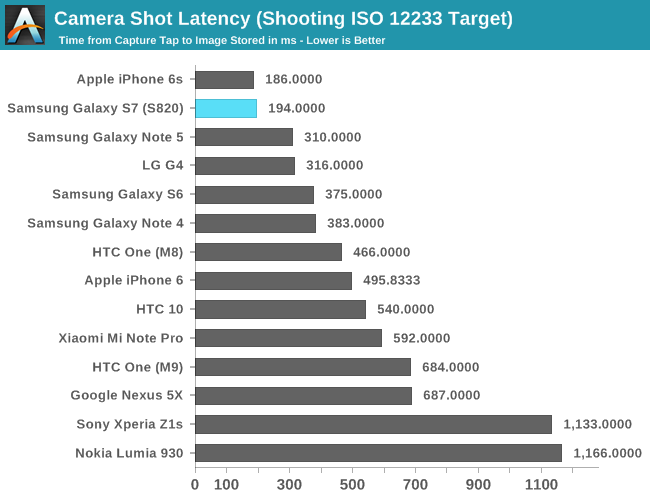
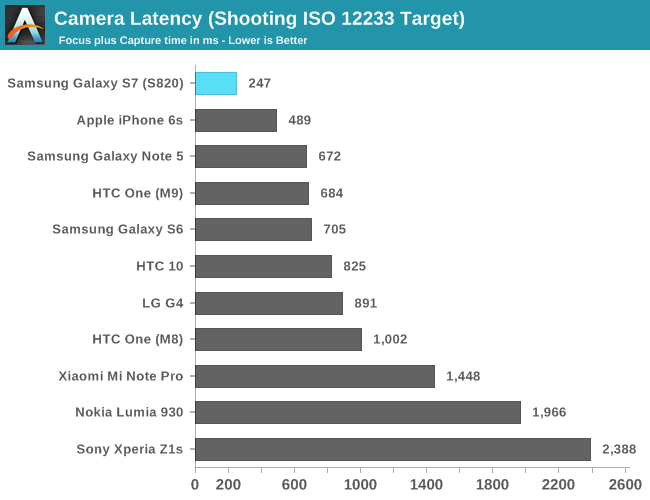
It’s probably not a surprise, but the Galaxy S7 is really, absurdly quick to take photos and focus. There is nothing out there that can realistically match the dual pixel AF system in the Galaxy S7, especially once you get into low light scenarios where traditional PDAF systems are overwhelmed by noise that can’t be easily canceled out. Samsung’s sheer prowess in semiconductor design and manufacture is really showing here, even in the best case.


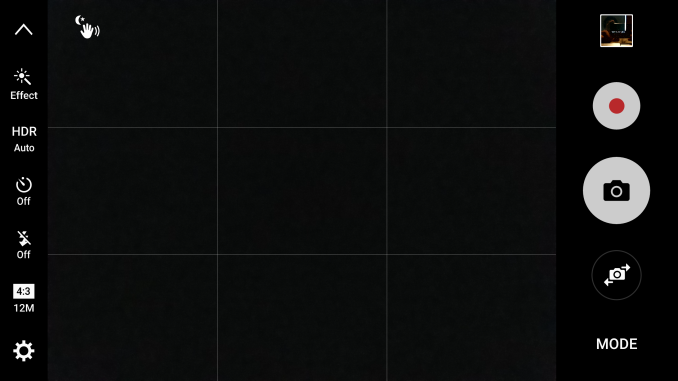
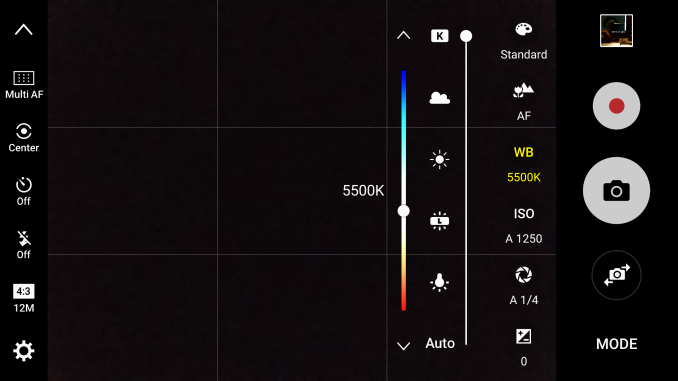
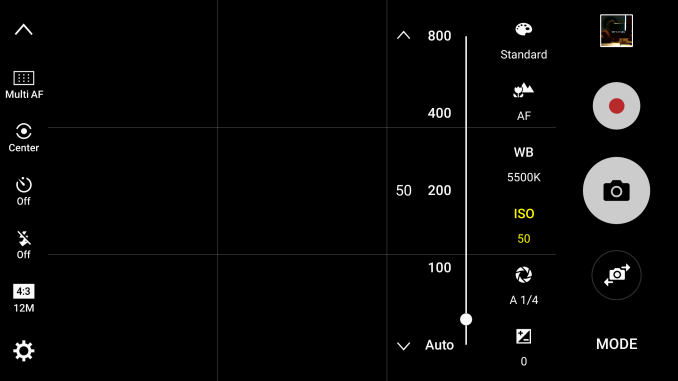








266 Comments
View All Comments
Michael Bay - Wednesday, July 6, 2016 - link
Somebody hasn`t lived in the nexus times then.more-or-less - Wednesday, July 6, 2016 - link
What has nexus got to do with themes?? your statements make no sense at all.Impulses - Thursday, July 7, 2016 - link
I don't get it either, and I have a Nexus 5... Shouldn't a theme just be a replacement of a series of textures and color profiles that are basically static and loaded just the same regardless of how they're tweaked?I found the comment by Joshua kinda suspect too, maybe I'm missing something, BUT I don't see how themes really help with Samsung's UI foibles either.
You might get rid of their color choices, at best, but it does nothing for all the substituted apps and extra UI elements you can't alter (never mind background processes and optimizations); those are the bigger issue with TouchWiz.
JoshHo - Thursday, July 7, 2016 - link
I'm not sure what exactly was done in the Android theming system but somehow some third party themes have noticeable effects on performance.Artmi$$ - Wednesday, July 6, 2016 - link
excuse me but where is the HTC 10 complete review ???retrospooty - Friday, July 8, 2016 - link
HTC 10 review? That isnt made by Apple, it wont come until 2017, if at all.lopri - Wednesday, July 6, 2016 - link
How AT can publish this low quality review after such a long wait is beyond me. It is almost as if the author, after many (justifiable) criticism directed to him, had decided to stick it up to readers in defiance.So very disappointed. Sort of editing and quality control by a seasoned reviewer is warranted, IMO.
R. Hunt - Wednesday, July 6, 2016 - link
Anandtech is slowly fading into irrelevance, this review being perfect proof of it: too late to matter, content not really warranting the long wait.ntp - Wednesday, July 6, 2016 - link
The Gear VR received no mention even though it's the best mobile VR and games like Anshar Wars 2 are insanely fun in multiplayer.The Vulkan API deserves at least some words, since it will increase performance significantly when proper implementations will come out.
Waterproofing adds considerable value also, since it can make the difference between buying a working phone or a brick.
And regarding cameras, how can you even compare Apple's F2.2 with F1.7?! They are in completely different leagues yet I see no mention of the advantages Samsung brought by having the fastest lens of any phone: lower exposure times (less handshake) or less noise. If you'd have used a DSLR camera you'd know that the F number is basically what you pay for in a lens, all other things being the same.
This is not a biased review. It's just... unprofessional. Too bad it took AT so long for something so incomplete.
Impulses - Thursday, July 7, 2016 - link
There's a heck of a lot more to a DSLR lens than aperture, specially if you're not chasing shallow DoF (which a phone can't manage in most circumstances).f2.2 vs f1.7 is actually 3/4ths of a stop, which isn't nothing but it's not like night and day either... It means shooting at 1/40 vs 1/80 or less than one ISO stop higher.
Nevermind that very often the f stop lies and it's not a true measure of light transmission, since it's merely and literally a ratio representing a physical iris measurement.
Glass coatings and other factors can affect actual light transmission, which is why cine lenses have more accurate T stops... Then you gotta figure in sensor size and efficiency, etc etc.